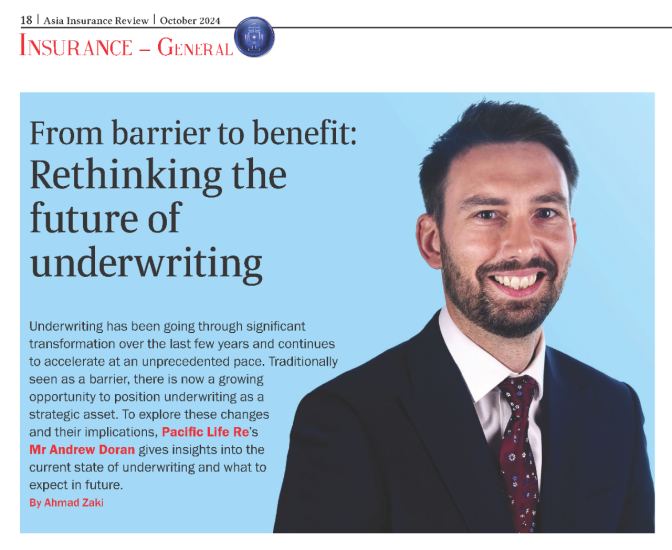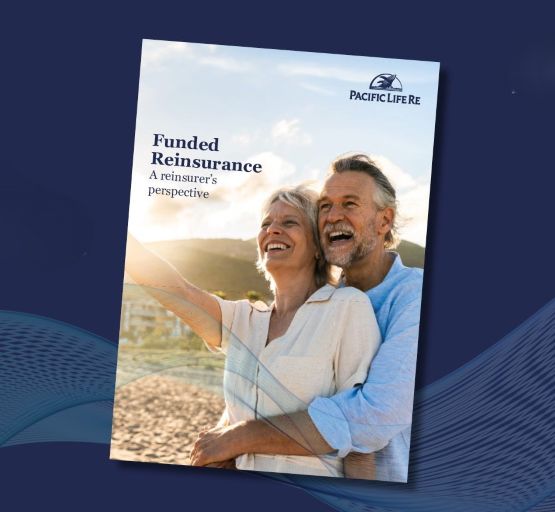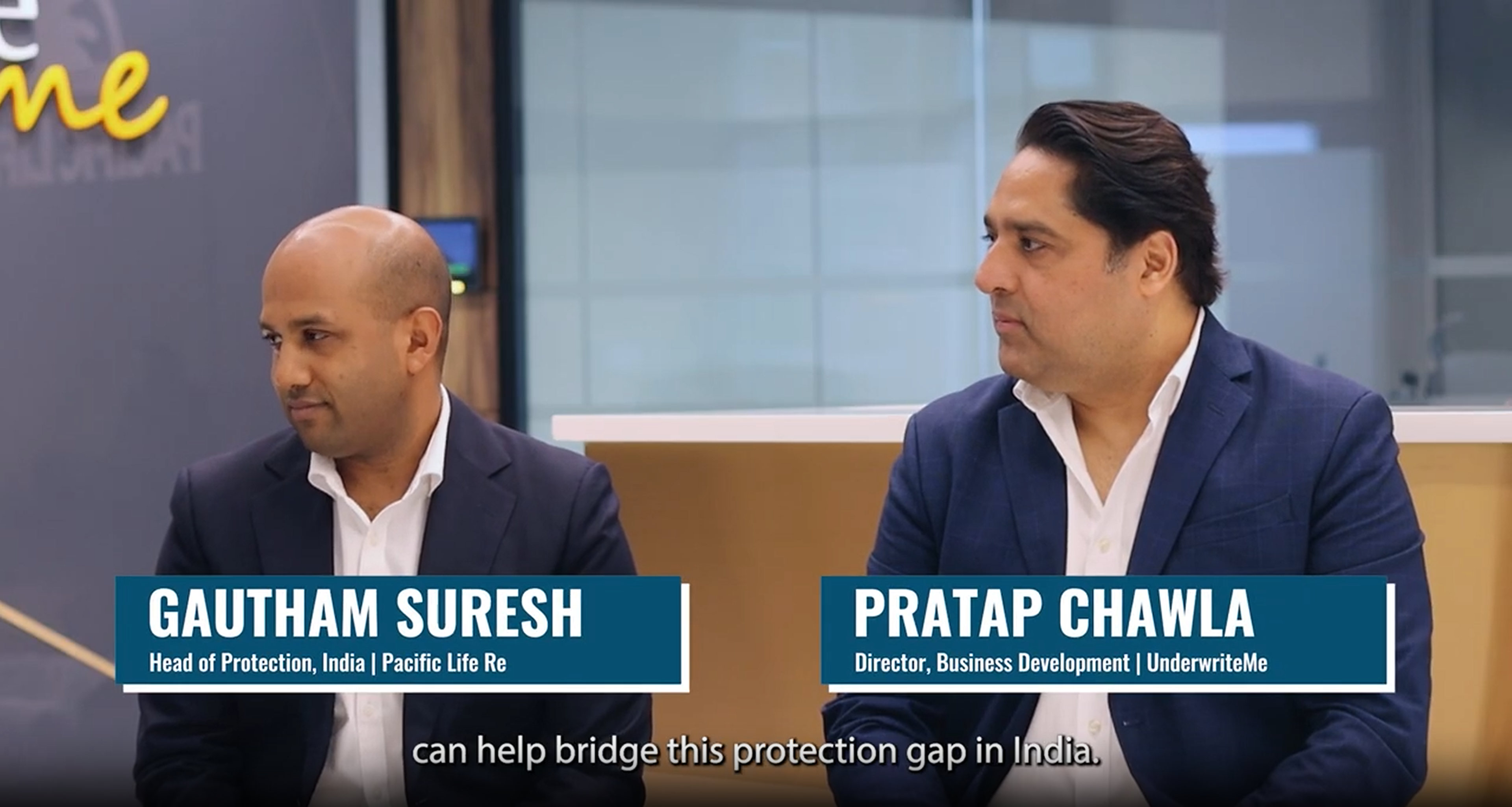Pacific Life Re | August 2024
Read
Underwriting has been going through significant transformation over the last few years and continues to accelerate at an unprecedented pace. Traditionally seen as a barrier, there is now a growing opportunity to position underwriting as a strategic asset. Andrew Doran, Pacific Life Re's Chief Underwriting & Claims Officer spoke to Asia Insurance Review to provide insights into the current state of underwriting and what to expect in future.

Underwriting has traditionally evolved steadily. What does the current landscape look like compared to the past?
In my role as global Chief Underwriting & Claims Officer with a view across many markets, I have witnessed firsthand the rapid evolution of the underwriting landscape.
Following the introduction of underwriting automation well over a decade ago, which sparked a notable shift in underwriting practices, we have seen only a gradual evolution. Until recently.
Whilst I, and many in our profession, have been talking about the use of data, AI and technology for a long time, it’s only in recent years where we’ve observed a more significant acceleration in its material use within day-to-day underwriting.
Today’s underwriting environment is marked by a growing shift towards digital solutions and AI integration, which contrasts sharply with the practices of the past.
Traditionally, underwriting involved a largely manual process. After completing an application form, a tree-based rules engine would process these answers to make an automated decision for around 50-80% of customers. For the remainder, underwriting evidence would be required, and a human underwriter would make the final decision. I would previously spend my time considering how we grind out 1-2% increases in automation, marginally increase non-medical limits, or tweak application questions based on anecdotal feedback or lower quality data analysis.
Today, modern data-driven underwriting is increasingly characterised by its reliance on digital tools, AI, and alternative data sources, driving a more dynamic and streamlined process. This shift results in faster and more accurate decisions, ultimately benefiting consumers. Judgement and expertise are important, but now, when I’m considering any changes in underwriting practice, my starting point is always ‘show me the data’, before working with clients to better understand the right changes that will have the biggest impact on the most meaningful measures of success.
What are the most common questions you hear about the role of AI and technology in underwriting?
Two of the most common questions I encounter are:
- Can alternative technology and data sources be used to replace traditional underwriting approaches?
- Can (or will) AI or generative-AI replace underwriting?
These are also questions I ask myself and my team regularly, and my perspective on this has evolved in the last few years. But the short answer continues to remain “yes, but…”.
While alternative data, technologies, and AI have the potential to enhance and further automate underwriting processes, and in some situations completely revolutionise the way underwriting is carried out, I continue to see human underwriters playing important roles in this future.
However, in some situations, the concept of ’underwriting’ might not exist at all, as industries embrace the use of connected data to seamlessly assess new and existing customers frictionlessly. We are already seeing this to a limited extent today in many countries across Asia, with China, Korea, and India, leading the way on connected data and how this is used to assess underwriting risks.
For the majority though, and everything I work with clients on, the future is aligned with AI and advanced technologies augmenting traditional underwriting practices rather than replacing them entirely, with human oversight remaining essential for complex cases and nuanced decision-making.
What does this transformation mean for the role of underwriters?
Even with technological advancements, human underwriters will remain crucial for handling the most complex cases, providing their deep technical knowledge and insight that automation and AI cannot.
However, the future of underwriting will in many ways be shaped by changes in that workforce. With alternative data sources, machine learning, and AI technologies becoming more prevalent, underwriting roles will need to adapt. Underwriters will increasingly need to act as intermediaries between the world of data science and the world of traditional underwriting, requiring a solid understanding of data analysis and its implications.
Underwriters of the future will need to be adept at interpreting complex data outputs and integrating them into the underwriting process and balancing technological advancements with human expertise. With the continued boom of InsurTech and HealthTech options, a particularly important skill will be in spotting the right opportunities to explore, and the right partners to connect with. Recent training sessions we have carried out are now more focused on developing these types of skills, and building confidence using data, to broaden underwriting skills, rather than deepen them technically / medically. This can be quite unsettling and frankly scary, but we’re in one of the most exciting times to be part of the underwriting and claims profession. The things I envisioned, but thought impossible, many years ago are now happening, and this brings opportunities for us to not only understand underwriting risk better, but develop ourselves, expand the reach of insurance, and make underwriting the reason people chose to buy, rather than the barrier that many see us today.

How do you envision the future of underwriting?
The future of underwriting is poised for radical evolution over the coming five to 10 years. We are already seeing some of these changes in action and we are actively supporting these initiatives. For instance, insurers in Malaysia use health claims data to predict future risks and streamline new applications, Singapore embraces video technology for carrying out medical exams, and machine learning algorithms are used to reduce manual underwriting referral rates in the United Kingdom and Singapore.
When it comes to augmentation of our current underwriting processes, there are three areas worth mentioning:
- Data-driven predictive underwriting, where traditional and non-traditional data sources are inter-connected with underwriting to offer tailored experiences to accelerate the previously manual process and expand the reach of insurance. This may mean that for some customers the underwriting process might not feel like underwriting at all, whereby they are seamlessly offered insurance coverage without any ‘tangible’ underwriting friction.
- Augmented underwriting rules engines with machine learning models to improve existing automation rates beyond what is achievable with the current rule-based systems. I see a lot of focus in this area, with many organisations having reached the limit by which traditional means of increasing Straight Through Processing (STP) rates are effective, and therefore looking towards AI to supplement this goal without compromising their risk assessment.
- Technology integration which will increasingly supplement or replace traditional underwriting evidence requirements, such as video technology for medical exams, or facial scanning technology that continues to evolve. So far, this hasn’t quite taken off in the way that many expected it might, but it’s an area where we should continue to pay close attention.
It is clear there will never be one-size-fits-all, and whilst all or some of the above will feature strongly in almost all future underwriting designs, the companies that will be most successful will be the ones who can connect traditional underwriting processes with data-driven modelling and third-party technology partnerships to create a seamless experience for consumers and advisers.
At Pacific Life Re and UnderwriteMe, we have and are committed to investing heavily in this area and collaborating closely with our partners to bring these advancements to fruition. Look out for our next article featuring Qian Hao Ong, our Global Head of Strategic Analytics, to learn more about our ongoing efforts.
What should professionals in the field be cautious about as they embrace these technological changes?
Whilst we absolutely must embrace this future, there are three key areas where caution is warranted:
- Regulatory Clarity: AI regulation is still evolving, and ensuring explainability in AI-driven processes is crucial for justifying underwriting outcomes fairly. This is essential to ensuring we not only broaden the reach of insurance, but we do it fairly and transparently, without creating uninsured pockets by focusing only on the cleanest lives that are easiest to automate.
- Risk Management: As it becomes easier and cheaper for consumers to gain insight into their long-term health through innovative digital and medical technologies, this introduces risks of information imbalance and anti-selection. Robust monitoring processes are essential to manage these risks effectively.
- Avoid Overcomplication: I see this, and have done this myself. Some of the opportunities that are becoming available to us are exciting and no doubt some will revolutionise insurance underwriting, but it’s important not to create solutions for problems that don’t exist. Focus on the key issues that need to be solved that add value for consumers and advisers. Think carefully about how you will measure success, and just because a technology solution can be implemented doesn’t mean it should be.
Conclusion
The underwriting landscape is undergoing a transformative phase. While the changes on the horizon and the pace of change can be daunting, it also presents exciting opportunities for innovation, growth, and to reposition underwriting as a significant value proposition. The future of underwriting lies in its ability to demonstrate clear benefits, enhance customer experience, and ultimately drive business success. As the industry continues to evolve, those who can effectively turn underwriting into a compelling reason to choose their services will be well-positioned to lead the market.
This article was first published on Asia Insurance Review.












.png)
.png)





















.png)